Being on top of the world is really hard on your calves. This was the conclusion I came to after walking up the steep slopes of the mountain town of Granada, Spain several times a day to return to our hotel.
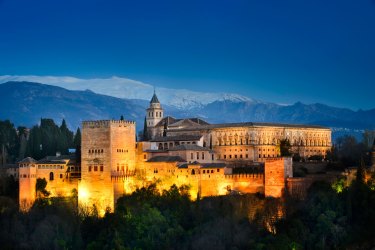
Perched on the knife’s edge of a cliff, the Hotel Alhambra Palace sits in the shadow of its namesake, the Alhambra, a massive fortressed city holding one of the most unique castles (they call it a palace, I don’t really know the difference) ever created in its bosom. Close-knit box-shaped white buildings with bleached terracotta roofs sprawl out beneath like subjects bowing to its majesty.
The fortress, first built by the Moors, has a complex history of occupants who all added their stamp. Several Arab leaders, then the well-known Ferdinand and Isabella, followed by a succession of Spanish kings created a sprawling city that melded architecturally diverse cultures on top of each other but left the original Moorish treasure relatively intact. It’s a place I expected to find arching ceilings covered in intricate patterns and tales of royal intrigue.
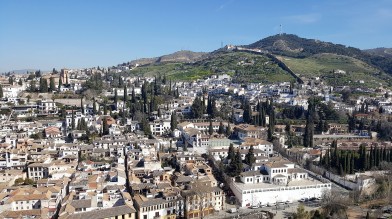
I did not expect to find Washington Irving.
Yes, the Washington Irving, of Sleepy Hollow fame. The gothic American author who, as far as I knew, was not Spanish nor royalty. So why has his imprint been left on this ancient castle?
Before we discover that, let’s take a trip through the Alhambra.
The History of the Alhambra
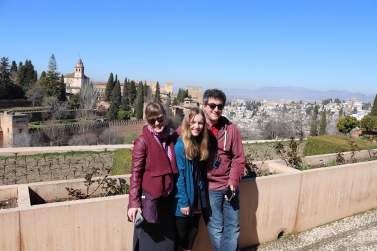 The Alhambra, meaning “The Red One” was built in AD 889 on the remains of Roman fortifications, and then largely ignored until its ruins were renovated and rebuilt in the mid-13th century by the Nasrid emir Mohammed ben Al-Ahmar. It’s orange walls, which turn red in the sunset, steeped in medieval turrets and mystery, were then converted into a royal palace in 1333 by Yusuf I, Sultan of Granada, the last bastion of the fading Arab empire in Spain.
The Alhambra, meaning “The Red One” was built in AD 889 on the remains of Roman fortifications, and then largely ignored until its ruins were renovated and rebuilt in the mid-13th century by the Nasrid emir Mohammed ben Al-Ahmar. It’s orange walls, which turn red in the sunset, steeped in medieval turrets and mystery, were then converted into a royal palace in 1333 by Yusuf I, Sultan of Granada, the last bastion of the fading Arab empire in Spain.
In 1492, when the Spanish reclaimed the area, the site became the Royal Court of Ferdinand and Isabella. (Side note: Christopher Columbus received royal endorsement for his expedition to the “new world” at the Alhambra.) Shockingly, instead of tearing down the palace, Ferdinand and Isabella, and their descendants, simply added to it in a strikingly incongruent Renaissance style that feels like the pyramid at the Louvre in its straight-lined, simple contrast to the flowing and ornate Moorish architecture.
The Music of the Alhambra
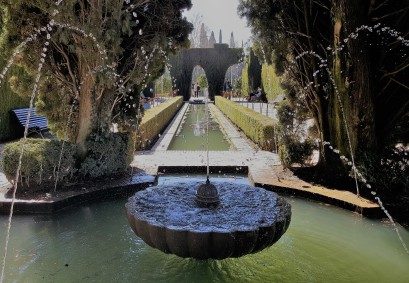 The Alhambra today has been mostly untouched and restored, except for the loss of the bright colors, which have now faded to white, like the statues of the ancient Greeks. Water bubbles up from fountains and small channels running through the grounds, a feat of engineering untouched since the Moors. The babbling of the water is the “music of the Alhambra,” as described by our guide.
The Alhambra today has been mostly untouched and restored, except for the loss of the bright colors, which have now faded to white, like the statues of the ancient Greeks. Water bubbles up from fountains and small channels running through the grounds, a feat of engineering untouched since the Moors. The babbling of the water is the “music of the Alhambra,” as described by our guide.
This calming trickle played for us like a background quartet as we walked from the grand palace, through the village, the gardens and the summer home. Sometimes plucky like a violin, other times soft and brooding like a cello, the water became the soundtrack to our tour. It played the keys of nature softly in our ears as we passed the orange tree groves and walked along the cobblestone to the furniture-maker.
The Hidden Poetry of the Alhambra
 The walls of the Alhambra are weaved with patterns. They curve and twist with leaves and petals mixed between geometric stars and diamonds. The repeated pattern motifs layer on top of each other like striations in the side of a mountain, building from the bottom of a wall to the top, where the ceiling explodes with a starry night sky.
The walls of the Alhambra are weaved with patterns. They curve and twist with leaves and petals mixed between geometric stars and diamonds. The repeated pattern motifs layer on top of each other like striations in the side of a mountain, building from the bottom of a wall to the top, where the ceiling explodes with a starry night sky.
It is the ceilings of the Alhambra that are the most striking. Some are dark wood with cutouts of stars that shine in the sunbeams rippling through the windows. It’s like standing inside a painting. The nature-themed walls form the representation of the Earth with the heavens above. Other ceilings drip with plaster, much like the stalactites from a cave, creating a feeling of celestial star frozen mid-burst.
 Walking through the Alhambra, I wished I had the head of an owl so that I could turn it nearly around and absorb all the intricate details.
Walking through the Alhambra, I wished I had the head of an owl so that I could turn it nearly around and absorb all the intricate details.
Stories abound in the Alhambra, whether its the echoes of Sultans who cruelly punished perceived slights or the poetry weaved into the tapestry of the walls in ancient Arabic letters, so beautiful in their physical construction they seamlessly blend with the natural artistic elements of the wall.
There are over 10,000 inscriptions on the walls of the Alhambra. One of the most common sayings is, “There is no Victor but Allah,” which is a refrain repeated throughout. But it’s not alone. The Alhambra walls are filled religious quotes, construction dates and poetry.
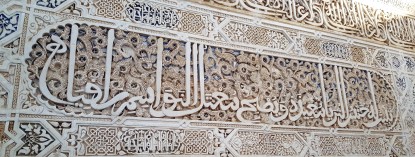 “Melted silver flows through the pearls,
“Melted silver flows through the pearls,
to which it resembles in its pure dawn beauty.
Apparently, water and marble seem to be one,
without letting us know which of them is flowing.
Don’t you see how the water spills on the basin,
but its spouts hide it immediately?”
This is only an excerpt of one of the many poems on the walls of the Alhambra, part of its many secrets. Who wrote it? Why was it placed there? These are just some of the many mysteries, on and within its walls, historians and visitors seek to understand, visitors like Washington Irving.
Washington Irving at the Alhambra
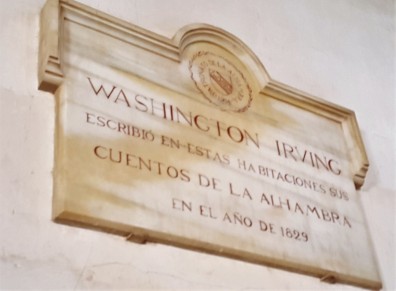 Clearly captivated by the beauty and mystery of the Alhambra, Washington Irving wrote the book The Tales of Alhambra.
Clearly captivated by the beauty and mystery of the Alhambra, Washington Irving wrote the book The Tales of Alhambra.
The book combines description, myth and narrations of real historical events at the Alhambra up through the destruction of some of the palace’s towers by the French in 1812, and the further damage caused by an earthquake in 1821.
“Perhaps there never was a monument more characteristic of an age and people than the Alhambra; a rugged fortress without, a voluptuous palace within; war frowning from its battlements; poetry breathing throughout the fairy architecture of its halls.”
― Washington Irving, Tales of the Alhambra
Although he tried, not even Irving felt he could truly capture the majesty and mystery of the Alhambra. “How unworthy is my scribbling of the place,” he once wrote. But his attempt is engraved on its walls, a plaque of his occupancy soaring above the doors on the way to a plush orange tree laden garden.
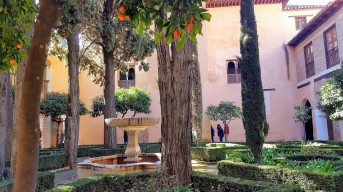 I can understand how Irving must have felt. They say a picture is worth a thousand words. I don’t think pictures or words can really capture the Alhambra. Although I’ve tried here in my own way (I’d never try to compare myself to Irving), there are some things in this world that must be seen to truly understand their wonder. What I’ve shown here, what Irving describes, it’s merely a shadow in a cave. To truly understand the beauty, it must be seen.
I can understand how Irving must have felt. They say a picture is worth a thousand words. I don’t think pictures or words can really capture the Alhambra. Although I’ve tried here in my own way (I’d never try to compare myself to Irving), there are some things in this world that must be seen to truly understand their wonder. What I’ve shown here, what Irving describes, it’s merely a shadow in a cave. To truly understand the beauty, it must be seen.
I hope everyone can experience the Alhambra or something like it at least once; a place that makes you feel as if you’re both completely insignificant and also grateful to be part of the historical fabric of life that created such a magical, wonderful, incredible place.















April 9, 2018 at 7:59 pm
This post made me look forward to my trip to Spain even more. I thought the photos were excellent. Thanks for sharing!
LikeLiked by 1 person
April 9, 2018 at 9:15 pm
That’s great! I’m sure you’ll have a great time. Where are you going in Spain?
LikeLike
April 9, 2018 at 9:18 pm
madrid, Seville, Granada, Toledo and Barcelona,
LikeLiked by 1 person
April 9, 2018 at 11:05 pm
Amazing! They are all such wonderful cities. The Guadi architecture in Bracelona is like nothing I’ve ever seen before. Make sure to book your tix for the alhambra ahead of time (if you’re planning to visit). They sell out fast! I hope you have a lovely time!
LikeLiked by 1 person
April 9, 2018 at 11:24 pm
Oh, thanks for the tip on Alhambra!
LikeLiked by 1 person
April 12, 2018 at 9:14 pm
Wow it looks so stunning! And very informative post!
LikeLiked by 1 person
December 8, 2018 at 1:46 am
If some one wishes expert view regarding running a blog
after that i recommend him/her to pay a visit this
webpage, Keep up the fastidious work.
LikeLiked by 1 person
December 31, 2018 at 1:01 pm
I read this piece of writing fully about the difference of hottest and preceding technologies, it’s amazing article.
LikeLike
August 19, 2019 at 10:27 pm
Perhaps in want of a fun night out, Kate Middleton and Prince
William sidled out to a Mayfair membership on Wednesday night with none other than…
Pippa!
LikeLiked by 1 person